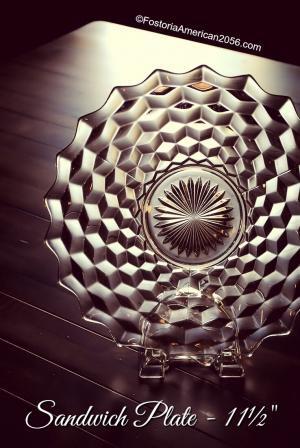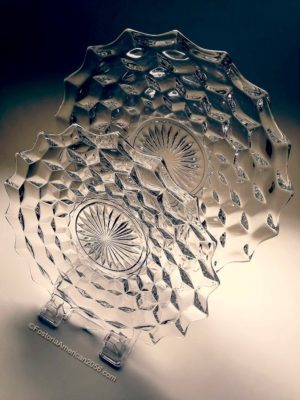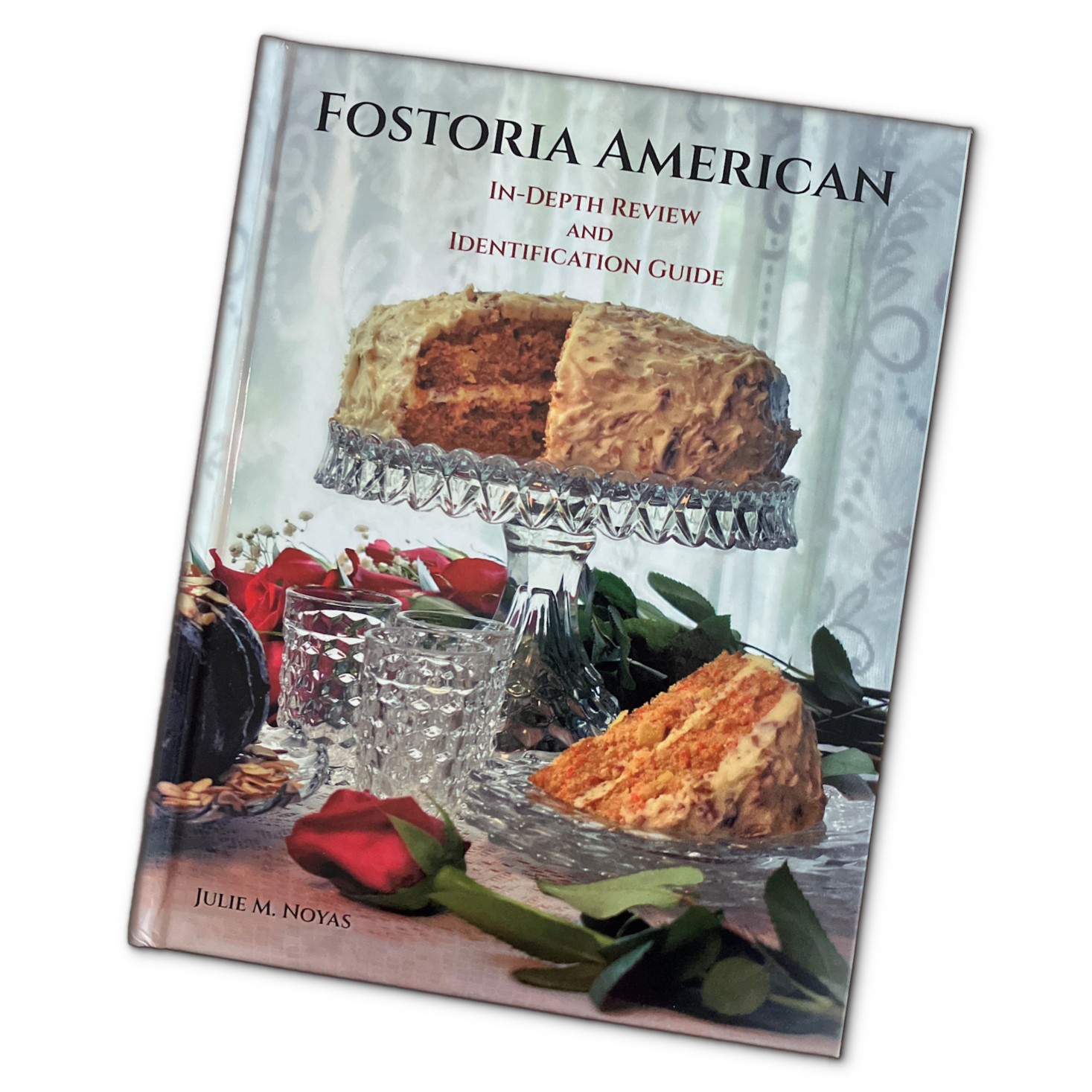by Julie Noyas | Jul 6, 2017 | Plates, Saucers, Tortes, & Tid Bits
Item Number: 558
Approximate Size: 11½″ D
Production Dates: 1915-1974
 This is the Fostoria American 11½″ Sandwich Plate, and it is the largest Sandwich Plate that was produced in the American pattern. Since it is featured in Fostoria’s 1915 Catalog Supplement, we know that it was produced in 1915 when Fostoria first introduced the American pattern. Three different sized Sandwich Plates were introduced at that time – the 9″, 10½″, and the 11½ inch.
This is the Fostoria American 11½″ Sandwich Plate, and it is the largest Sandwich Plate that was produced in the American pattern. Since it is featured in Fostoria’s 1915 Catalog Supplement, we know that it was produced in 1915 when Fostoria first introduced the American pattern. Three different sized Sandwich Plates were introduced at that time – the 9″, 10½″, and the 11½ inch.
The 11½″ Sandwich Plate had a long life and remained in the American line until approximately 1974. After Fostoria Glass closed its factory, this piece was never reproduced by the Lancaster Colony Corporation.
An interesting fact about this particular Sandwich Plate is that it is often confused with other items in the Fostoria American line. Many times it is erroneously sold as a Cake Plate. Even more commonly, it’s often misclassified as a Cracker Plate – the piece that accompanied the Footed Cheese. Both assumptions are wrong; however, it is easy to understand the confusion since all the pieces are approximately the same size and look almost identical. The key words being “almost identical”.
There is one physical characteristic that distinguishes the Cracker Plate from the 11½″ Sandwich Plate – and that is a raised retainer ring. The true Sandwich Plate does not have a raised retainer ring in the center of the plate; however, the Cracker Plate does. The retainer ring helps to hold the Footed Cheese in place so that it does not slip around on the Cracker Plate. Therein lies the difference, and it is an easy one to spot if you know what to look out for.
As an eBay Partner, I may be compensated if you make a purchase on eBay. The following link shows available Sandwich Plates on eBay.
by Julie Noyas | Jun 27, 2017 | Plates, Saucers, Tortes, & Tid Bits
Item Number: 371
Approximate Size: 11½″
Production Dates: 1938-1970
 Fostoria Glass Company produced an item in their American line that was called the “Cheese and Cracker”. It consisted of two individual pieces – the Footed Cheese, and the Cracker Plate. When these pieces were produced, you could either buy the two-piece set together – or you could buy the Footed Cheese and/or the Cracker Plate independently of each other. For this reason, you often see the pieces separated or misidentified.
Fostoria Glass Company produced an item in their American line that was called the “Cheese and Cracker”. It consisted of two individual pieces – the Footed Cheese, and the Cracker Plate. When these pieces were produced, you could either buy the two-piece set together – or you could buy the Footed Cheese and/or the Cracker Plate independently of each other. For this reason, you often see the pieces separated or misidentified.
The Cracker Plate is approximately 11½″ in diameter. The Cracker Plate and the large 11½″ Sandwich Plate look very similar; however, they are not the same plate. Even today, most people don’t know the difference and sell one as the other. Since the two plates are almost identical in style and size, it is easy to understand the confusion.
Over the years, and especially most recently, I see the Cheese and Cracker set sold with the wrong plate. Quite often, it is sold with the 11½″ Sandwich Plate. The difference between the two plates is that the Cracker Plate has a raised retainer ring in the center; the Sandwich Plate does not. The retainer ring helps to hold the Footed Cheese in place so that it does not slip around on the plate. As you can see, the Footed Cheese fits snugly inside the ring on the true Cracker Plate.
For a view of the item that sits on top of the Cracker Plate, please refer to the Footed Cheese. To see both items together, please refer to the Cheese & Cracker.
As an eBay Partner, I may be compensated if you make a purchase on eBay. The following link shows available Cheese and Crackers on eBay.
by Julie Noyas | Jun 12, 2017 | Plates, Saucers, Tortes, & Tid Bits
Item Number: P-02
Approximate Size: 6½″
Production Dates: 1915-1943
The Fostoria American Finger Bowl Plate served as an underplate for the Finger Bowl. Many people today have never heard of using such a bowl or plate; however, in bygone years it was a custom that was used just prior to serving the dessert course. The original Finger Bowl Plate is featured in the 1915 Catalog Supplement, which is when it was first produced.
It has been published in one book on Fostoria American that two versions of the Finger Bowl Plate were produced – the old version that has a smooth edge (pictured in this post), and a newer version which has a serrated edge. Based on my research, I can not verify that statement. Searching through official Fostoria documentation and catalogs, I have not been able to document where Fostoria Glass used any other underplate for the Finger Bowl other than the one shown in this post. The “newer” version that some people refer to is simply an Ice Tea Plate.
The Finger Bowl Plate is easy to recognize if you look for three things – the edges, the center design, and the size. Being approximately 6½″ in diameter, there is one distinguishing factor that I think is most important – the mould from which it came from. The Finger Bowl Plates were made from the same mould as the Finger Bowl. The Finger Bowl Plate is a flattened out Finger Bowl. Why is that important? Because, if you were to set the Finger Bowl on an authentic Finger Bowl Plate … and look straight down upon it, you would see the exact same center design mirrored against each other. The next time you are in the market to buy a Finger Bowl and Plate – simply take a look at their center design and see if they match up. If they do, you’re in luck!
Many times; however, the Finger Bowls are sold with other plates – like the Saucer or the Bread and Butter Plates. Educate yourself and learn the differences. As an eBay Partner, I may be compensated if you make a purchase on eBay. The following link shows available Finger Bowl Plates on eBay.
by Julie Noyas | May 25, 2017 | Plates, Saucers, Tortes, & Tid Bits
Item Number: 554
Approximate Size: 10½″ D
Production Dates: 1915-1982
This is the Fostoria American 10½″ Sandwich Plate, and it is a versatile piece to have in your collection. Since it is featured in Fostoria’s 1915 Catalog Supplement, we know – without a doubt – that it was produced in 1915 when Fostoria first introduced the American pattern. Three different sized Sandwich Plates were introduced at that time – the 9″, 10½″, and the 11½ inch.

The 9″ and 10½″ Sandwich Plates
The 10½″ Sandwich Plate had a long life and remained in the American line until approximately 1982. It had the longest production run of all the Sandwich Plates. After Fostoria Glass closed its factory, this piece was later reproduced by the Lancaster Colony Corporation.
An interesting fact about the Sandwich Plates is that they were used in two other Fostoria American pieces – the 10½″ Handled Cake Tray, and the Tid Bit Set (with a metal handle). The plates that were used for the Handled Cake Tray and Tid Bit Sets were drilled, and had a hole in the center of the plate to accommodate the metal handle. The 10½″ Sandwich Plate is the bottom plate that was used on both pieces, and the 9″ Sandwich Plate is the top plate on the Tid Bit Set.
Published books on Fostoria American have stated that the Sandwich Plates used for the Handled Cake Tray and the Tid Bit Sets had edges that flared up higher than edges on the regular Sandwich Plates. While I have seen this to be true on several pieces, I can attest that this summation is not always valid. My personal Handled Cake Tray (factory produced, not homemade drilled) has a flared plate edge of only one inch; however, some of my regular 10½″ Sandwich Plates have flared edges measuring in at 1¼″″ or higher. These pieces were handmade, and with that comes size variations.
As an eBay Partner, I may be compensated if you make a purchase on eBay. The following link shows available Sandwich Plates on eBay.
by Julie Noyas | May 20, 2017 | Plates, Saucers, Tortes, & Tid Bits
Item Number: 479
Approximate Size: 7″ D
Production Dates: 1938-1958 Cream Soup Plate; 1934-1973 Mayonnaise Plate
 The plates that were used as underplates for the Mayonnaise and the Cream Soups are actually the same plate. The plates are described as being 7″ in size; however, my own personal pieces are closer to 7½″ in size. Please remember that these pieces were finished by hand, and slight variations in size are to be expected.
The plates that were used as underplates for the Mayonnaise and the Cream Soups are actually the same plate. The plates are described as being 7″ in size; however, my own personal pieces are closer to 7½″ in size. Please remember that these pieces were finished by hand, and slight variations in size are to be expected.
While this piece was known by two different names, the item number that was assigned by Fostoria was the same (479). Two variations of these plates were made. In order to keep the dishes from sliding around on the plates, one version of the plate has a raised retainer ring in the center (shown highlighted on the left). The second variation does not have a raised retainer ring; rather, it has a slight depression in the center of the plate and looks very much like a regular Salad Plate.
The Mayonnaise Plate definitely adds a finishing touch when paired with the flat-bottom Mayonnaise – and when topped with a glass ladle, they make for a beautiful (and very functional) serving piece.
When the Cream Soup and the Cream Soup Plate are paired together, they also make for a beautiful duo. The Cream Soup dish is quite lovely, boasting gently curved handles on both sides of its flared shape. For a view of the item that sits on top of the Cream Soup Plate, please refer to the Cream Soup.
As an eBay Partner, I may be compensated if you make a purchase on eBay. The following link shows available Cream Soup/Mayonnaise Plates on eBay.
by Julie Noyas | Apr 29, 2017 | Plates, Saucers, Tortes, & Tid Bits
Item Number: P-01
Length: 7½″
Production Dates: 1937-1944
The Crescent Salad Plate is a plate like no other. Uniquely formed, it instantly captures your attention. The American Salad Plates came in two formations – round, or crescent-shaped. The Crescent Salad Plate is approximately 7½” in length, and about 4½” wide. The top serrated edges flair upward (not sideways), giving the plate a nice side margin to hold the contents of a salad or other food item.
It is of my opinion that these plates should be stored carefully. Since the serrated edges flare upwards (and not to the sides as with the round salad plates) it is a plate that should not be stacked on top of one another. If space is limited – and you find that you have no alternative other than to stack them – make sure that you cushion each plate adequately in order to prevent any damage to the points.
The Crescent Salad Plate did not have a long production life, only being made from approximately 1937-1944. You can usually expect to pay more for the crescent-shaped plates versus the regular round plates.
As an eBay Partner, I may be compensated if you make a purchase on eBay. The following link shows available Crescent Salad Plates on eBay.
 This is the Fostoria American 11½″ Sandwich Plate, and it is the largest Sandwich Plate that was produced in the American pattern. Since it is featured in Fostoria’s 1915 Catalog Supplement, we know that it was produced in 1915 when Fostoria first introduced the American pattern. Three different sized Sandwich Plates were introduced at that time – the 9″, 10½″, and the 11½ inch.
This is the Fostoria American 11½″ Sandwich Plate, and it is the largest Sandwich Plate that was produced in the American pattern. Since it is featured in Fostoria’s 1915 Catalog Supplement, we know that it was produced in 1915 when Fostoria first introduced the American pattern. Three different sized Sandwich Plates were introduced at that time – the 9″, 10½″, and the 11½ inch.
 Fostoria Glass Company produced an item in their American line that was called the “Cheese and Cracker”. It consisted of two individual pieces – the
Fostoria Glass Company produced an item in their American line that was called the “Cheese and Cracker”. It consisted of two individual pieces – the 
 The plates that were used as underplates for the Mayonnaise and the Cream Soups are actually the same plate. The plates are described as being 7″ in size; however, my own personal pieces are closer to 7½″ in size. Please remember that these pieces were finished by hand, and slight variations in size are to be expected.
The plates that were used as underplates for the Mayonnaise and the Cream Soups are actually the same plate. The plates are described as being 7″ in size; however, my own personal pieces are closer to 7½″ in size. Please remember that these pieces were finished by hand, and slight variations in size are to be expected.